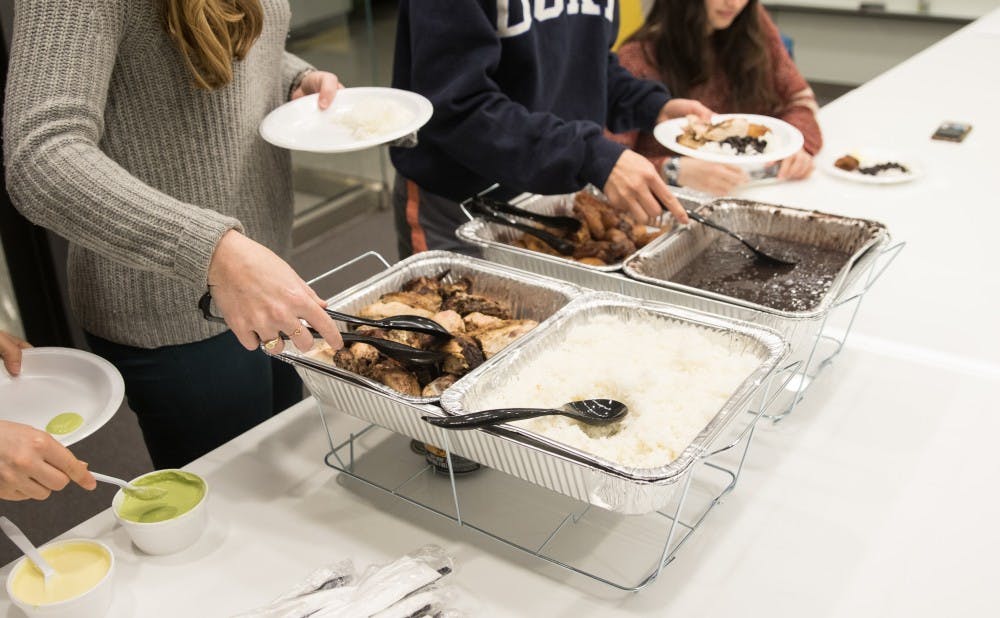Hold on to your alpacas, because a Peruvian restaurant may soon be coming to your doorsteps.
The Duke University Student Dining Advisory Committee met Thursday to discuss the possibility of bringing Alpaca Peruvian Charcoal Chicken, a restaurant on Ninth Street that opened last year, into the Merchants-on-Points program. If added, Alpaca will join 11 other venues, including Domino’s Pizza and Jimmy John’s, that offer nighttime deliveries to Duke’s campus. But the meeting was hazy on details.
Chanibel Diaz, a representative for Alpaca, explained that their restaurant is equipped to make on-demand campus deliveries. Alpaca participates in the My Hot Lunchbox program—an Apex, N.C.-based service that delivers hot meals to local schools—and its catering business has served up to 200 people at once in the past.
But a number of DUSDAC members expressed concerns over the proposal, asking about the logistics of running a large-scale delivery service.
“For high-volume orders, how far in advance would you need to know?” asked senior Julia Leuchtenburg, a committee member. “If a lot of people happen to order in one hour, is that emptying out the fresh food that you just made?”
Diaz said that, per restaurant policy, customers must order at least 24 hours in advance for meals serving more than 15 people. She did not elaborate if the same catering policy would apply to the Merchants-on-Points program.
Senior Julia Medine, co-chair of the committee, asked if Alpaca would be willing to extend its hours upon joining the program. Most Merchants-on-Points vendors start delivering at 8 p.m. to avoid competition with the Brodhead Center, with many offering deliveries well past midnight. Alpaca, however, closes its doors at 9 p.m.
“I don’t think they’ll do it, but I can ask,” Diaz said.
Other members asked about delivery fees, food preparation, transport options and even the containers in which the food would be delivered. At the end, sophomore Aryaman Gupta questioned if Alpaca fully understood the Merchants-on-Points program. Medine, however, said the vague answers may have been due to miscommunication.
“They probably didn’t realize that we would ask questions about it,” Medine said. “They may have just thought we wanted samples.”
Disagreements over logistics aside, the committee was unanimous in its praise for the food provided—rice and beans, sweet plantains and rotisserie chicken.
In other business
The committee also discussed other issues surrounding dining at Duke, including the inconvenience of ordering from the 300 Swift apartment complex, reports of subtle price hikes at Ginger and Soy and the ongoing friction between Wilson Gym and the health food store Quenchers.
Aris Marton, assistant director of retail operations for Duke Dining, noted that Wilson officials wanted Quenchers to “liven up the space” by transitioning it to be more food-based.
Another key point of discussion involved suggestions for a Latin American food concept on campus.
“We want more variety representing different countries,” said junior Alejandra Aguilar, a representative from Duke’s largest undergraduate Latinx organization, Mi Gente. She said a comprehensive, daily menu would be ideal, but a rotating menu of highlighted cultures may be more realistic.
Sophomore Sujeiry Jimenez, another Mi Gente representative, suggested that Duke Dining could work off a static base of foods common to many Latin American cuisines—such as rice, beans, plantains and yuca—and diversify from there.
“A lot of Latin food has the same base, so that would be smart,” he said.
Marton said that she will take the organization’s ideas into consideration.
“It’s not possible to please everyone,” she said. “But we want to please as many people as we can. We don’t want to leave anyone out.”
Get The Chronicle straight to your inbox
Signup for our weekly newsletter. Cancel at any time.

